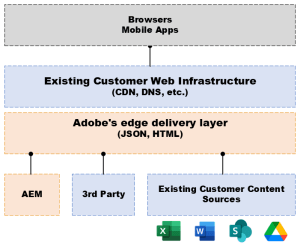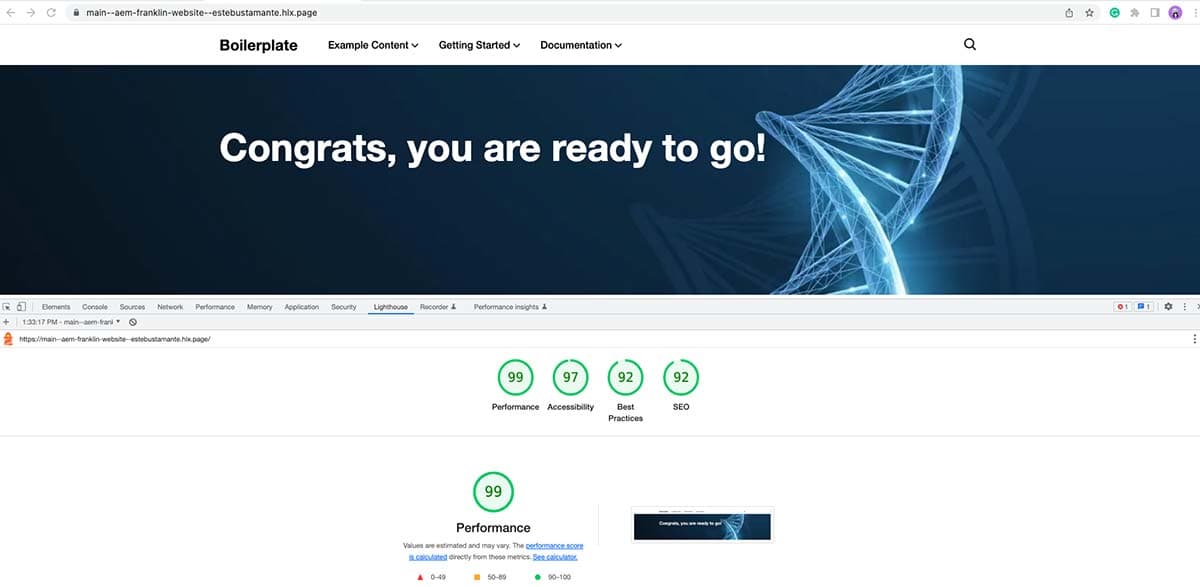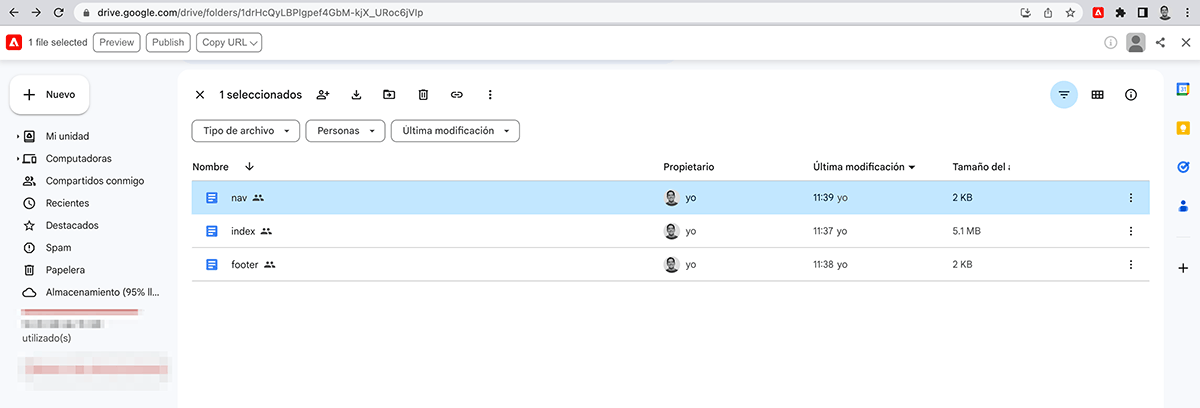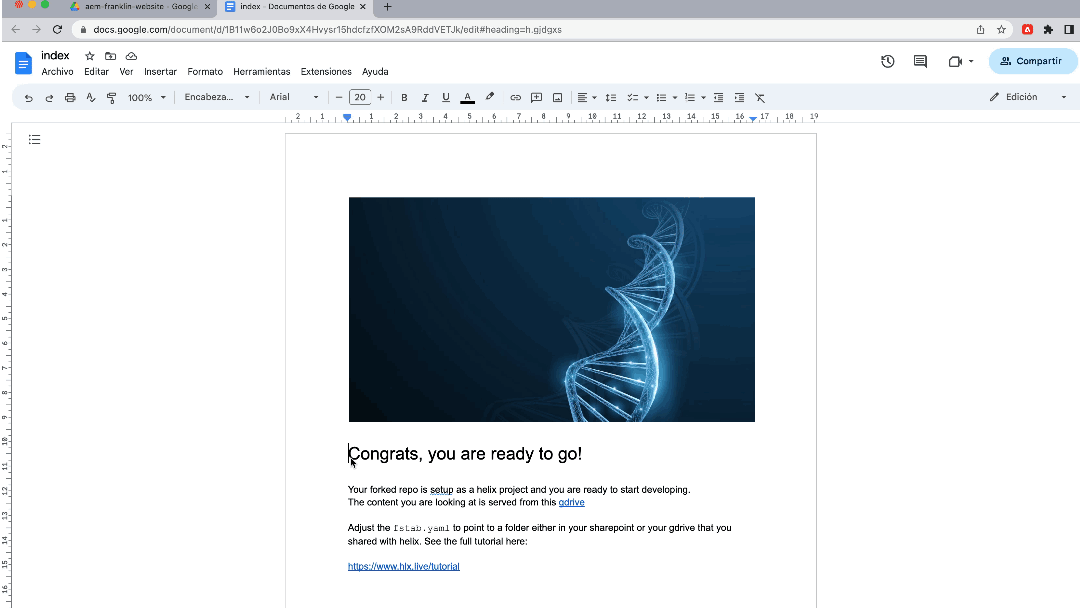

Jun 12, 2023
Websites that load quickly can engage users effectively, leaving them with a favorable impression and a desire to delve deeper into the content. By enhancing the speed of your website, you can provide outstanding user experiences and increase your conversion rates.
In this blog, we will explore some of the most recent Adobe features set to unleash a new generation of tools that will empower us to craft lightning-fast websites.
Next-Gen Composability
Why is this “next-gen”? Adobe is trying to change the paradigm by proposing a new “performance-first” delivery architecture that will ensure a website can hit the top scores (100%) of web core vitals metrics.

This architecture tries to decouple the CMS’s pattern of having a “repository” bound to a “CMS server”. Instead, it proposes multiple “repositories” (or sources) which can take advantage of CMS “services”.
Here is where the former Adobe’s Project Helix and now Project Franklin come into play. Sometimes it can be referred to as “Next-Gen Composability“ (NGC), but in plain English, this is an Adobe Experience Manager feature built with the premise of “performance-first”.
From the official site: “Franklin is a feature of Adobe Experience Manager and a new kind of web content management system by Adobe that creates sites that are fast, helps authors to publish quickly, and gets new sites launched rapidly”. Consider this: when making decisions about technology and frameworks for a website, we often prioritize other factors over performance and speed. With Next-Gen Composability, the game has changed. Instead of creating a site first and then optimizing it to achieve a high score (ideally 100%), the new approach is to build a website from the ground up with a 100% score in mind and maintain that performance over time. This shift in mindset revolutionizes how we approach website development, ensuring that speed is a top priority from the start.
Now, let’s try to answer some common questions.
What are the benefits of Next-Gen Composability?

-
Peak Speed and Performance: Perhaps the most attractive benefit, it includes a real user monitoring service (RUM) that checks how fast your site is for visitors in the real world. This gives you more accurate performance data than lab results like the Lighthouse score. Also, it will run a performance audit on each new deployment.
-
Launch Faster: The tools provided to publish, create and serve websites are easy to use and do not require a significant learning curve. Adobe has stated that a project that usually takes months can be delivered in days or weeks.
-
Re-use content from your existing sources: Do you have Excel sheets or Word documents where website data is kept? In a traditional authoring flow, you must feed that info into another source (CMS) before seeing that data on a website. Next-Gen Composability is integrated to use Google Docs and Microsoft SharePoint as a content source, eliminating the chance of duplicating effort in such situations.
-
Decrease the authoring learning curve: Leveraging common tools well-known by users (e.g. Google Docs and Microsoft SharePoint) make the authoring experience natural. Literally, any user can become an author in a matter of minutes.
-
Exact preview of your changes: The changes are deployed into a server equal to your production site. This guarantees that the preview is 100% faithful to the live site.
-
Low-code approach: It eliminates the need for complex API knowledge, making website development accessible to a wider range of individuals. Anyone can confidently build a site with basic HTML, CSS, and JS knowledge. It offers ready-to-use “blocks” for faster site creation, similar to AEM’s core components.
In what scenarios would this be a suitable choice?
Project Franklin is a versatile choice suitable for both microsites and knowledge-based websites. Moreover, it excels in handling large-scale sites with multiple authors, frequent updates, and high traffic. In the case of extensive, well-established websites, it is common to have numerous distinct origins interconnected on a CDN tier. This setup enables the utilization of separate AEM Franklin projects for different sections or parts of the site, extending to origins powered by diverse content management systems (CMS).
How are pages edited?

As mentioned, it supports editing content in Microsoft Word, Google Docs, Microsoft Excel, and Google Sheets, as well as any custom authoring environment and AEM’s Universal Editor.
When initiating a new project, you can designate the source where the project will be linked, such as selecting a Google Drive folder. Additionally, it is essential to install and utilize the “sidekick” browser extension, specifically created for previewing, publishing, and deleting pages. With these tools in place, you can make modifications directly within the document sections corresponding to the page and easily preview and publish the changes as required.
What other features are supported?
You can use the other Adobe products without problems (e.g. Target, Analytics, and Launch). A paid CDN is also supported (Akamai, CloudFront, etc.). Perhaps one of the most important things to mention is that the capabilities of tools such as Microsoft Word, Google Docs, Microsoft Excel, and Google Sheets are incorporated and used to build the websites. For example, if you want to build a multilingual site, you can simply take advantage of the localization capabilities that are integrated with such tools. Similarly, with inheritance and rollout between multiple sites, the content rollout can be tied into the existing content source (eg. Sharepoint and GDrive).
Also, it is important to mention that you can achieve several website actions that you are used to, such as adding a sitemap, adding redirects, etc.
Can I use it now?

At this point, Franklin is exclusively available to existing Adobe Experience Manager Sites customers by invitation only. Adobe has launched a “VIP” program, where you can apply to start using these new tools with their guidance. But in the meantime, Adobe offers a Developer Tutorial where you can get your hands on it and start playing.
Wrapping Up
Adobe’s upcoming Next Generation of Composability is set to revolutionize website performance. While customer access to tools like the AEM Universal Editor and AEM Project Franklin may not be fully available yet, the previews shared by Adobe have generated significant excitement. Keep an eye out for future announcements to stay updated on these promising developments.









